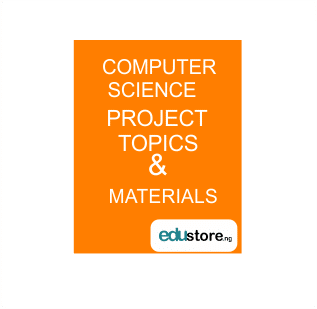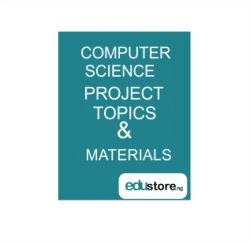ABSTRACT
The research work “computer animation for nursery pupils” is an application that uses animation in educating nursery students. This system replaces the manual way of animation display which include the use of static materials with dynamic materials.
Chapter one is an introduction to the project to describe what the project entails. It discusses the problems in the existing system. Also described in chapter one are the aim, the objectives, the significance and the limitation of the study.
Chapter two is the literature review of the project which contain diverse research and scholarly articles written of this project while chapter three describes the method of data collection, system analysis and design and improvement on the proposed system.
Chapter four describes the implementation and result of the project and lastly, chapter five gives the summary, conclusion and recommendation.
CHAPTER ONE
INTRODUCTION
1.1 Background to the Study
Long before the development of cinematography, humans have attempted to depict motion as far back as the Paleolithic period. Shadow play and the magic lantern offered popular shows with projected images on a screen moving as the result of manipulation by hand and/or some minor mechanics. In 1833, the stroboscopic principle used in modern animation was introduced by the Phenakistiscope and which would also provide the basis for cinematography.
The presence of several examples of untimely sequential images that may seem related to set of animation drawings. Although, it is not likely that these images were directed to be seen as animation but most of these instance of images would only allow a very low frame rate when animated, giving rise to an unpolished animations that are not very lifelike.
The possibility of imaging a technology that could have been deployed in the periods of their creation, but no definite evidence in artifacts or descriptions have been found. It is often debated that these untimely or early sequential images are translated as pre-cinema too easily by minds accustomed to film, comic books and other modern sequential images, while it is uncertain that the creators of these images envisioned anything like it. The notion of instances smaller than a second that are necessary to break down an action into sufficient phases for fluent animation would not really develop before the 19th century.
Early examples of attempts to capture the phenomenon of motion into a still drawing can be found in Paleolithic cave paintings, where animals are often depicted with multiple legs in superimposed positions. It has been claimed that these superimposed figures were intended for a form of animation with the flickering light of the flames of a fire or a passing torch illuminating different parts of the painted rock wall, revealing different parts of the motion.
Education in the general sense is any act or experience that has a formative effect on the mind, character, or physical ability of an individual. In its technical sense, education is the process by which society deliberately transmits its accumulated knowledge, skills, and values from one generation to another. Education can also be defined as the process of becoming an educated person.
Childhood has changed rapidly over the past few years and the methods that teachers or educators use for children and young people should reflect these changes. Children learn best and most when they enjoy what they are doing. Using animation as a tool to encourage and develop children’s learning is not only fun but effective. By using animation, children develop skills competencies in storytelling, visual communication, cognition, emotional, ethic and aesthetic aspects, observation and sensory aspects, concentration and problem-solving and innovative aspects.
1.2 Statement of Problems
The problem in the current system is the use of static materials. Static materials involve concrete objects or images that don’t appear to change position. This problem of these static images to children is that they do not improve the creativity of the children and thereby making learning not quite interesting and boring to a child.
1.3 Aim and Objectives of the Study
The aim of this research is to develop a computer animation for nursery pupils.
The objectives of this research are as follows:
- To introduce graphics to the pupils as a good educational instructional material to enhance learning.
- Developing an animation of the existing method so as to prepare children to welcome and face the future with smile and confidence.
- Explore design consideration involved in the development of effective animated materials for learning
- To demonstrate the use of C# programming language as a good educational technology in enhancing learning.
- Illustrate the cognitive effects of animated learning materials used in a classroom.
1.4 Methodology
The basic method used in this project involves using a waterfall model. The major tool used in accomplishing the building of the software is Microsoft Visual C# – Winforms Application because of its event driven nature.
1.5 Significance of the Study
The significance of this study is therefore to adopt computer technology which illustrates with graphics and animations, playing with human voice an instructional material designed to aid the retention and assimilation of a child thereby creating a joyful, interactive and interesting environment for a child to learn through illustrations, examples and interactive tools particularly designed to emphasize on the hard spots of the regular curriculum
1.6 Scope of the Study
The scope of this research is to develop computer animation for early childhood only. It does not cover toddlerhood, middle childhood and adolescence and adult.
1.7 Limitation of the Study
This research work is limited to animation of animals using alphabets A-Z, roman numerals of number 1 – 1000 and human anatomy.
1.8 GLOSSARY OF TERMS
LABEL: A Label object is a component for placing text in a container.
SCENE: A scene is used to organize a document in an ordered manner.
STAGE: The Stage is where animation and images appear. It represents the visible area of the project that is been worked on.
ANIMATION: The technique of making inanimate objects or drawings appear to move in motion pictures or computer graphic.
THREAD: A thread is a program’s path of execution. In this project it is used to control the time in playing the sound for each scene.
SYMBOLS AND INSTANCES: A symbol is a reusable object that serves as a master from which copies of the same object can be created. An instance is a copy of the original symbol. An object’s instance color, size, shape, and position can be altered without it affecting the original symbol.
FRAME: A frame is used to organize and control the content of one’s document.
DOWNLOAD COMPLETE WORK NOW
DOWNLOAD COMPLETE WORK- For Reference Only: Materials are for research, citation, and idea generation purposes and not for submission as your original final year project work.
- Avoid Plagiarism: Do not copy or submit this content as your own project. Doing so may result in academic consequences.
- Use as a Framework: This complete project research material should guide the development of your own final year project work.
- Academic Access: This platform is designed to reduce the stress of visiting school libraries by providing easy access to research materials.
- Institutional Support: Tertiary institutions encourage the review of previous academic works such as journals and theses.
- Open Education: The site is maintained through paid subscriptions to continue offering open access educational resources.






